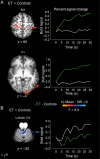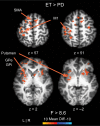Functional Brain Activity Relates to 0-3 and 3-8 Hz Force Oscillations in Essential Tremor
- PMID: 24962992
- PMCID: PMC4816778
- DOI: 10.1093/cercor/bhu142
Functional Brain Activity Relates to 0-3 and 3-8 Hz Force Oscillations in Essential Tremor
Abstract
It is well-established that during goal-directed motor tasks, patients with essential tremor have increased oscillations in the 0-3 and 3-8 Hz bands. It remains unclear if these increased oscillations relate to activity in specific brain regions. This study used task-based functional magnetic resonance imaging to compare the brain activity associated with oscillations in grip force output between patients with essential tremor, patients with Parkinson's disease who had clinically evident tremor, and healthy controls. The findings demonstrate that patients with essential tremor have increased brain activity in the motor cortex and supplementary motor area compared with controls, and this activity correlated positively with 3-8 Hz force oscillations. Brain activity in cerebellar lobules I-V was reduced in essential tremor compared with controls and correlated negatively with 0-3 Hz force oscillations. Widespread differences in brain activity were observed between essential tremor and Parkinson's disease. Using functional connectivity analyses during the task evidenced reduced cerebellar-cortical functional connectivity in patients with essential tremor compared with controls and Parkinson's disease. This study provides new evidence that in essential tremor 3-8 Hz force oscillations relate to hyperactivity in motor cortex, 0-3 Hz force oscillations relate to the hypoactivity in the cerebellum, and cerebellar-cortical functional connectivity is impaired.
Keywords: Parkinson's disease; cerebellum; essential tremor; fMRI; grip force; motor control.
Published by Oxford University Press 2014. This work is written by (a) US Government employee(s) and is in the public domain in the US.
Figures





References
-
- Baarbe J, Yielder P, Daligadu J, Behbahani H, Haavik H, Murphy B. 2014. A novel protocol to investigate motor training-induced plasticity and sensorimotor integration in the cerebellum and motor cortex. J Neurophysiol. 111:715–721. - PubMed
-
- Bell EC, Willson MC, Wilman AH, Dave S, Silverstone PH. 2006. Males and females differ in brain activation during cognitive tasks. Neuroimage. 30:529–538. - PubMed
Publication types
MeSH terms
Substances
Grants and funding
LinkOut - more resources
Full Text Sources
Other Literature Sources

